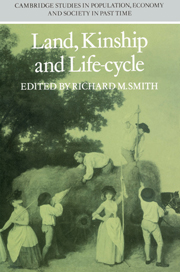Book contents
- Frontmatter
- Contents
- List of contributors
- Preface
- 1 Some issues concerning families and their property in rural England 1250–1800
- 2 Population pressure, inheritance and the land market in a fourteenth-century peasant community
- 3 Families and their land in an area of partible inheritance: Redgrave, Suffolk 1260–1320
- 4 Population changes and the transfer of customary land on a Cambridgeshire manor in the fourteenth century
- 5 Industrial employment and the rural land market 1380– 1520
- 6 Changes in the size of peasant holdings in some west midland villages 1400–1540
- 7 The erosion of the family–land bond in the late fourteenth and fifteenth centuries: a methodological note
- 8 Changes in the link between families and land in the west midlands in the fourteenth and fifteenth centuries
- 9 Kinship in an English village: Terling, Essex 1550–1700
- 10 The myth of the peasantry: family and economy in a northern parish
- 11 Poverty, poor relief and the life-cycle: some evidence from seventeenth-century Norfolk
- 12 The receipt of poor relief and family situation: Aldenham, Hertfordshire 1630–90
- 13 Widows in pre-industrial society: an essay upon their economic functions
- 14 Real property, marriage and children: the evidence from four pre-industrial communities
- 15 The nineteenth-century peasantry of Melbourn, Cambridgeshire
- Consolidated Bibliography
- Index
2 - Population pressure, inheritance and the land market in a fourteenth-century peasant community
Published online by Cambridge University Press: 19 October 2009
- Frontmatter
- Contents
- List of contributors
- Preface
- 1 Some issues concerning families and their property in rural England 1250–1800
- 2 Population pressure, inheritance and the land market in a fourteenth-century peasant community
- 3 Families and their land in an area of partible inheritance: Redgrave, Suffolk 1260–1320
- 4 Population changes and the transfer of customary land on a Cambridgeshire manor in the fourteenth century
- 5 Industrial employment and the rural land market 1380– 1520
- 6 Changes in the size of peasant holdings in some west midland villages 1400–1540
- 7 The erosion of the family–land bond in the late fourteenth and fifteenth centuries: a methodological note
- 8 Changes in the link between families and land in the west midlands in the fourteenth and fifteenth centuries
- 9 Kinship in an English village: Terling, Essex 1550–1700
- 10 The myth of the peasantry: family and economy in a northern parish
- 11 Poverty, poor relief and the life-cycle: some evidence from seventeenth-century Norfolk
- 12 The receipt of poor relief and family situation: Aldenham, Hertfordshire 1630–90
- 13 Widows in pre-industrial society: an essay upon their economic functions
- 14 Real property, marriage and children: the evidence from four pre-industrial communities
- 15 The nineteenth-century peasantry of Melbourn, Cambridgeshire
- Consolidated Bibliography
- Index
Summary
The first half of the fourteenth century witnessed the culmination of the first of three great waves of population growth which may be discerned during the pre-industrial period. At the same time, the living standard of the mass of the population reached a nadir below which it was never again to fall, with a substantial proportion living at a level which was marginal for bare subsistence. England's population of four to six millions was, in fact, at least three, and possibly even four, times greater than it had been some two-and-a-half centuries earlier. The consequence of so great an increase in population, according to M. M. Postan, was that it ultimately brought about its own nemesis. An over-concentration upon grain production, coupled with deficient agricultural technology, led to soil exhaustion and the abandonment of land and thus to a real decline in agricultural production: a decline, moreover, which was exacerbated during the late thirteenth and early fourteenth centuries by a succession of bad harvests of which the worst – the so-called Great Famine – occurred in 1315–17. The latter event precipitated a major subsistence crisis from which the population never fully recovered. In Postan's view, therefore, when bubonic plague arrived in 1348–9 it struck a population which was already in decline.
Postan's neo-Malthusian explanation of events has found favour with a great many medieval economic and social historians. Indeed, insofar as it has met with serious challenge this has been directed less against the circumstantial nature of so much of his evidence than against his ascription of the role of prime mover to demographic trends.
- Type
- Chapter
- Information
- Land, Kinship and Life-Cycle , pp. 87 - 134Publisher: Cambridge University PressPrint publication year: 1985
- 6
- Cited by

